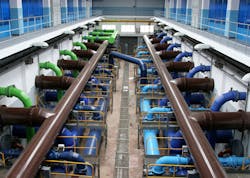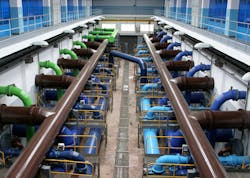The Future of Drives & Automation in the Water Industry
The use of automated systems in order to make pumps and processes work more efficiently is helping keep pace with modern demands. What does the future hold for one of the most pivotal products in the automation mix, the inverter drive?
By Oliver Endres
New technologies are being used to meet the challenges of clean and wastewater processing and movement in many, many installations both large and small around the world.
Examples in the EU include projects as diverse as one of the most ambitious wastewater treatment projects in Europe, designed to process several towns’ wastewater and improve water quality along the Sussex coast in the UK. Southern Water’s largest ever capital project, this £300 million environmental improvement scheme includes a new wastewater treatment works (WWTW) and sludge recycling centre, two pumping stations, 11 km of sewer tunnel and a 2.5 km long sea outfall. The newly completed works can treat 95,000 cubic metres of wastewater each day.
Another significant example is the Lake Constance Water Supply Association project to provide a reliable supply of drinking water to four million inhabitants in 320 towns and municipalities by taking water from Lake Constance. The drinking water is produced at Sipplinger Berg and then transported via a pipeline network 1,700 kilometres long to the 181 members of the association. The updating of the system enabled the distribution of 125 million cubic metres of drinking water per annum as well as the demand-led storage of nearly 500,000 cubic metres.
Inverters
Not surprisingly, inverters or variable speed drives are seen as a key technology for helping the industry address these issues. Originally developed to bring more control to industrial processes, inverters can also reduce electric motors’ energy consumption significantly. Both of these characteristics are very attractive to the water industry.
One of the most important attributes water engineers look for when specifying equipment is long design life, and inverters are not exempt from this. Therefore a robust design and reliable components are essential. Additionally, water engineers will need their inverters to be adaptable, because they may want to redeploy them to a different duty in five, ten or even fifteen years’ time.
Inverter controlled pumps can be used to match supply to demand throughout the distribution network, providing more water at peak times and trimming it back, say at night, when demand drops off. Reducing the pressure in the distribution network like this has a considerable effect on losses due to leakage. Similarly, processes like aeration, chemical infeed and sewage treatment can be more precisely controlled through the use of inverters on various pumps and motors.
For many years the water industry used valves to reduce flow at times of low demand. But this meant that the pump motors continued to work at full speed, which used a lot of energy. It is also notable that motors were often oversized for their basic duty so that they had a bit of extra power in reserve, but this did mean that they constantly drew more energy. The modern alternative is to add inverter control to the motors, which allows pump speeds to be reduced at times of low demand to save energy.
An important advantage of inverters is that when they are running equipment at less than full speed, there is a consequent reduction in wear and tear in addition to saving energy. This can lead to reduced service and maintenance requirements, which in the case of remote and hard to access pumping stations can represent a significant cost saving in logistics alone.
Furthermore, the ideal water industry inverter should be able to run automatic self-diagnostic checks and transmit the results wirelessly back to the technical department, so that engineers do not have to travel to site for routine work.
Water hammer
The electronic intelligence of an inverter can also be put to use for issues that are specific to the water industry, such as controlling water hammer and unblocking systems or ‘deragging’.
The water industry likes its inverters to be able to soft start pumps and other equipment and to be able to recognise the repeated pressure fluctuations of water hammer and to smooth them out. This not only reduces maintenance and repair demands but can also extend motor life by reducing stresses in the electrical system.
Deragging is the common water industry term for unjamming the impeller of a pump, which is often caused by a build-up of rags or other fibrous debris in the pipework. The problem is almost inevitable, even though screens and filters are fitted throughout water plant facilities and the wider distribution network. Clearing a blocked pump can be very disruptive and very expensive because it may involve closing a part of the distribution network, craning out the affected pump and dismantling it. Therefore the water industry has been keen to encourage inverter companies to develop self-deragging drives. Put simply, the inverter should be able to detect any increase in local pressure and trigger a self-clearing sequence that will consist of increasing power and/or cycling the pump back and forward to see if the blockage can be dislodged and dispersed.
In fact such inverters can be programmed to fine tune this basic operation to best suit each individual situation. The routines in the latest inverters are further optimised and are able to detect these situations almost perfectly, using an intelligent pump curve matching algorithm rather than set-point triggers. The drive can determine when blockages can be overcome, when they can be resolved automatically and when severe drops or rises in system pressure call for a smooth shut-down.
Harmonic disruption
The sort of large inverters employed in the water industry used to have a reputation for causing harmonic disruption to the electrical mains supply and affecting the power quality. This could compromise any electrical equipment in the surrounding area, both within the water works and beyond to neighbouring properties. However the latest generation of drives has addressed this by incorporating active filter technology that typically reduces distortion down to less than 5% THDi (Total Harmonic Distortion of Current).
Engineers are often torn between specifying a product that has been designed specifically for the job in hand and one of a more standard design that should have a lower overall cost of ownership because it will be bought in larger volumes and used in a number of installations. For water engineers, the choice is between inverters designed specifically for pumps and those designed for general purpose duties on aerators, conveyors and other equipment commonly found in water works.
Fortunately some manufacturers have managed to resolve this issue by developing inverters that use standard hardware but are given application-specific characteristics and features in the software. A pump-rated inverter for instance will be ‘tuned’ to meet the torque control requirements of a pump. It will also be configurable for single and multi-pump installations and have pump related functions such as automatic level and pressure control, soft starting and deragging algorithms.
A couple of decades ago the water industry could have been described as a bit of a sleepy backwater in the engineering world, but today it is facing challenges of epic proportions, ones that could change the world completely.
Inverter drives are now one of the key technologies for ensuring success. The drive of the future then, to a certain extent, is here now; they can communicate wirelessly, an operator can visualise them within a system, monitor and control them securely via a mobile device, they will sort problems out on their own, work incredibly efficiently at different speeds and loads, reduce maintenance costs and burdens as well as being easier to set-up as they are self-calibrating.
A recent UK Framework Agreement between South East Water and Mitsubishi Electric, for example, demonstrates the demand for these drives. They will be employed to serve a population of 2.1 million people, supplying safe, high quality drinking water to 880,000 properties. The inverter drives are being supplied along with PLCs, HMIs and associated equipment in addition to integration support, training, extended warranties, software updates and bespoke 24/7 technical support.
Oliver Endres is European product manager inverter, Mitsubishi Electric Europe B.V., Factory Automation European Business Group.
More Water & WasteWater International Archives Issue Articles

